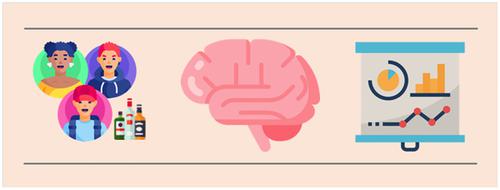当前位置:
X-MOL 学术
›
Eur. J. Neurosci.
›
论文详情
Our official English website, www.x-mol.net, welcomes your
feedback! (Note: you will need to create a separate account there.)
Alcohol use and brain morphology in adolescence: A longitudinal study in three different cohorts
European Journal of Neuroscience ( IF 2.7 ) Pub Date : 2021-08-14 , DOI: 10.1111/ejn.15411 Hanan El Marroun 1, 2, 3 , Eduard T. Klapwijk 4, 5 , Martijn Koevoets 6 , Rachel M. Brouwer 6 , Sabine Peters 4, 5 , Dennis Ent 7 , Dorret I. Boomsma 7 , Ryan Muetzel 1 , Eveline A. Crone 3, 5 , Hilleke E. Hulshoff Pol 6 , Ingmar H. A. Franken 1, 3
European Journal of Neuroscience ( IF 2.7 ) Pub Date : 2021-08-14 , DOI: 10.1111/ejn.15411 Hanan El Marroun 1, 2, 3 , Eduard T. Klapwijk 4, 5 , Martijn Koevoets 6 , Rachel M. Brouwer 6 , Sabine Peters 4, 5 , Dennis Ent 7 , Dorret I. Boomsma 7 , Ryan Muetzel 1 , Eveline A. Crone 3, 5 , Hilleke E. Hulshoff Pol 6 , Ingmar H. A. Franken 1, 3
Affiliation

|
Alcohol consumption is commonly initiated during adolescence, but the effects on human brain development remain unknown. In this multisite study, we investigated the longitudinal associations of adolescent alcohol use and brain morphology. Three longitudinal cohorts in the Netherlands (BrainScale n = 200, BrainTime n = 239 and a subsample of the Generation R study n = 318) of typically developing participants aged between 8 and 29 years were included. Adolescent alcohol use was self-reported. Longitudinal neuroimaging data were collected for at least two time points. Processing pipelines and statistical analyses were harmonized across cohorts. Main outcomes were global and regional brain volumes, which were a priori selected. Linear mixed effect models were used to test main effects of alcohol use and interaction effects of alcohol use with age in each cohort separately. Alcohol use was associated with adolescent's brain morphology showing accelerated decrease in grey matter volumes, in particular in the frontal and cingulate cortex volumes, and decelerated increase in white matter volumes. No dose–response association was observed. The findings were most prominent and consistent in the older cohorts (BrainScale and BrainTime). In summary, this longitudinal study demonstrated differences in neurodevelopmental trajectories of grey and white matter volume in adolescents who consume alcohol compared with non-users. These findings highlight the importance to further understand underlying neurobiological mechanisms when adolescents initiate alcohol consumption. Therefore, further studies need to determine to what extent this reflects the causal nature of this association, as this longitudinal observational study does not allow for causal inference.
中文翻译:

青春期饮酒和大脑形态:三个不同队列的纵向研究
酒精消费通常在青春期开始,但对人类大脑发育的影响仍然未知。在这项多站点研究中,我们调查了青少年饮酒与大脑形态的纵向关联。荷兰的三个纵向队列(BrainScale n = 200,BrainTime n = 239 和 Generation R 研究的子样本n = 318) 年龄在 8 至 29 岁之间的典型发育参与者。青少年饮酒是自我报告的。收集至少两个时间点的纵向神经影像数据。处理管道和统计分析在队列之间进行了协调。主要结果是全局和区域脑容量,这是先验选择的。线性混合效应模型用于分别测试每个队列中酒精使用的主要影响和酒精使用与年龄的交互作用。饮酒与青少年的大脑形态有关,显示灰质体积加速减少,特别是额叶和扣带皮层体积,以及白质体积减速增加。没有观察到剂量反应关联。这些发现在较老的队列(BrainScale 和 BrainTime)中最为突出和一致。总之,这项纵向研究表明,与不饮酒的青少年相比,饮酒的青少年灰质和白质体积的神经发育轨迹存在差异。这些发现强调了进一步了解青少年开始饮酒时潜在神经生物学机制的重要性。因此,进一步的研究需要确定这在多大程度上反映了这种关联的因果性质,因为这项纵向观察研究不允许进行因果推断。这些发现强调了进一步了解青少年开始饮酒时潜在神经生物学机制的重要性。因此,进一步的研究需要确定这在多大程度上反映了这种关联的因果性质,因为这项纵向观察研究不允许进行因果推断。这些发现强调了进一步了解青少年开始饮酒时潜在神经生物学机制的重要性。因此,进一步的研究需要确定这在多大程度上反映了这种关联的因果性质,因为这项纵向观察研究不允许进行因果推断。
更新日期:2021-09-21
中文翻译:

青春期饮酒和大脑形态:三个不同队列的纵向研究
酒精消费通常在青春期开始,但对人类大脑发育的影响仍然未知。在这项多站点研究中,我们调查了青少年饮酒与大脑形态的纵向关联。荷兰的三个纵向队列(BrainScale n = 200,BrainTime n = 239 和 Generation R 研究的子样本n = 318) 年龄在 8 至 29 岁之间的典型发育参与者。青少年饮酒是自我报告的。收集至少两个时间点的纵向神经影像数据。处理管道和统计分析在队列之间进行了协调。主要结果是全局和区域脑容量,这是先验选择的。线性混合效应模型用于分别测试每个队列中酒精使用的主要影响和酒精使用与年龄的交互作用。饮酒与青少年的大脑形态有关,显示灰质体积加速减少,特别是额叶和扣带皮层体积,以及白质体积减速增加。没有观察到剂量反应关联。这些发现在较老的队列(BrainScale 和 BrainTime)中最为突出和一致。总之,这项纵向研究表明,与不饮酒的青少年相比,饮酒的青少年灰质和白质体积的神经发育轨迹存在差异。这些发现强调了进一步了解青少年开始饮酒时潜在神经生物学机制的重要性。因此,进一步的研究需要确定这在多大程度上反映了这种关联的因果性质,因为这项纵向观察研究不允许进行因果推断。这些发现强调了进一步了解青少年开始饮酒时潜在神经生物学机制的重要性。因此,进一步的研究需要确定这在多大程度上反映了这种关联的因果性质,因为这项纵向观察研究不允许进行因果推断。这些发现强调了进一步了解青少年开始饮酒时潜在神经生物学机制的重要性。因此,进一步的研究需要确定这在多大程度上反映了这种关联的因果性质,因为这项纵向观察研究不允许进行因果推断。









































 京公网安备 11010802027423号
京公网安备 11010802027423号